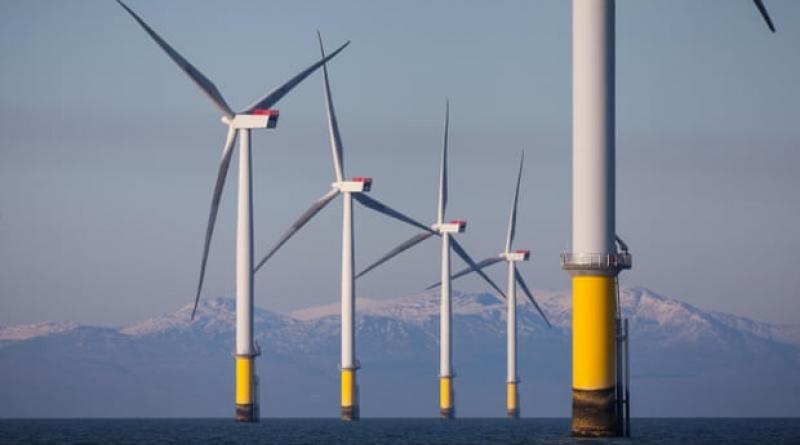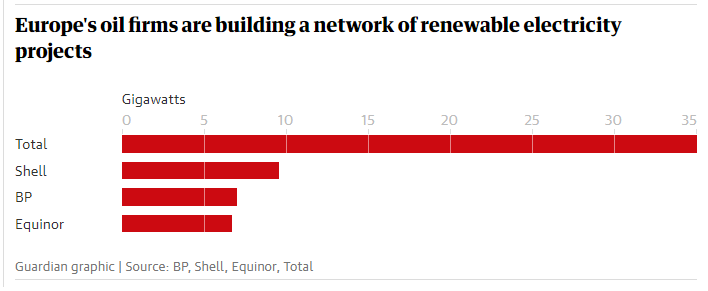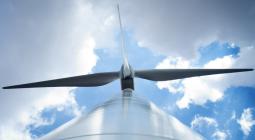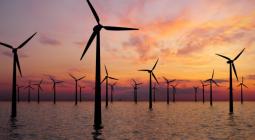Why oil giants are swapping oil rigs for offshore windfarms.

The fossil fuel giants need to find new ways to reduce emissions, generate growth and maintain their share price.
The world’s biggest oil companies are no stranger to UK waters, but by the end of the decade they will be running more offshore wind turbines than oil rigs.
BP has already made a splash with a record-breaking bid to build two giant windfarms in the Irish Sea. The company beat established renewable energy players by offering to pay the Crown Estate £900m a year to develop the sites, more than 15 times the price paid for similar deals in the past.
Bernard Looney, the chief executive of BP, said the winning bid, announced earlier this week, marked the company’s entry into one of the world’s best offshore wind markets.
“This is both important progress towards BP’s transformation into an integrated energy company as well as a significant next step in our long history in the UK,” Looney added.
It has also marked a new battleground between oil companies and the traditional energy utilities they hope to emulate and usurp. BP’s big windfarm bet has drawn criticism from renewable energy developers which placed bids more in line with the results of previous seabed auctions – and lost. They claim that the price to be paid by BP is too steep, and the returns on investment will be too low.
“They’re mad,” said an employee of one windfarm developer. “Everyone is saying the same thing; these prices make no sense, and will ultimately be bad for the industry and consumer bills.”
Dev Sanyal, the head of BP’s renewable energy division, takes the warnings from BP’s critics with a pinch of salt. “They would say that, wouldn’t they?” he told the Guardian.

He said the planned Irish Sea windfarms represent a “highly advantaged” entry point into the company’s future growth.
The turbines will stand in relatively shallow waters, 18 miles offshore, meaning it will be cheaper and easier to build and maintain. The two windfarms together will be able to share resources, driving costs lower still. These factors are critical to keeping costs low and investment returns at between 8% to 10%, a level expected by BP’s investors.
However, taking a wider strategic view, BP and other major oil companies are willing to pay top-dollar to join the offshore wind boom in UK waters and around the world because they need to diversify from polluting fossil fuels into cleaner renewable energy.
BP hopes to increase its portfolio of renewable energy to 50GW by 2030. The newly won option on the UK seabed follows a $1.1bn (£850m) deal to take a stake in two US offshore wind projects being developed by Norwegian state oil company Equinor. To keep growing BP will need to compete against traditional renewable energy developers – and other oil companies.
Anglo-Dutch oil company Shell is also pursuing offshore wind. It has teamed up with Dutch renewable energy company Eneco to build giant windfarms off the coast of the Netherlands. French major Total was also a winner in the UK’s latest seabed auction.
Mark Lewis, the chief sustainability strategist at BNP Paribas Asset Management, a major investor in renewable energy, said “Big Oil’s” big spending on offshore wind is an investment in their long-term future.
“There is an overarching imperative now, which is no longer in question, that the UK and Europe must reduce their carbon emissions to net zero by 2050. So any oil company operating in the UK knows two things: one, that it needs to reduce the emissions from its operations and two, that it needs to find alternatives to oil for its future growth,” Lewis said.
There is also a clear message from investors writ-large across the world’s stock market indices. Listed companies with a strong stable of renewable energy projects are beginning to reach market valuations many times the size of their annual earnings, while oil company share prices are grazing multi-year lows.
BP’s share price only four months ago plunged to its lowest level since 1994. The 26-year low on the FTSE 100 valued the company at £40.5bn, well below the market value of the Danish offshore wind developer Orsted, which in less than two years has doubled its value on the Copenhagen stock exchange to more than £51bn.
“Happily for oil companies there are opportunities in offshore wind,” Lewis said. “It is a great growth market where they already have some transferable skills because the engineering proposition is very similar. We’re talking about building big infrastructure in the middle of the sea, and that’s something we know oil companies do well.”
Even the world’s largest offshore windfarms are easily dwarfed by the scale and expense of the multibillion-dollar fossil fuel projects which are routine for major oil companies. BP believes its track record delivering giant offshore infrastructure projects, ahead of schedule and below budget, will help to reduce the cost of building offshore windfarms too.
“This is exactly what we should be doing; we’re bringing our skills from the old world to the new world. That’s why we think we can be a winner in the energy transition,” BP’s Sanyal said.
Investors have already raised questions over whether the company has overpaid, according to Lydia Rainforth, an oil and gas equity analyst at Barclays.
But she warned against comparing BP’s bid to the prices offered by utility companies. For one thing, each seabed licence has different characteristics which could affect the economics of a windfarm. For another, there has been no price set for the electricity the windfarms will eventually generate, so BP’s returns on the investment will remain unknown for years.
For now the upfront costs represent a “relatively small outlay” in the context of oil company spending, and an important step in moving towards a greener energy portfolio.
Rainforth said: “It does appear a price worth paying. And for now we have to trust that the company has done the work to back up the 8% to 10% return [on investment] ambition.”
10 February 2021
The Guardian




